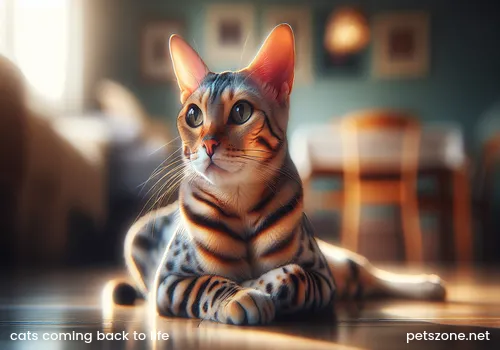The Miracle of Cats Coming Back to Life_Real Cases Shock Even Veterinarians
The story of cats "coming back to life" sounds incredible, but there may be scientific explanations behind it, such as a state of suspended animation, successful cardiopulmonary resuscitation, or hypothermia. Although "cats have nine lives" is just a saying, cats do sometimes show amazing vitality and self-rescue abilities, and these real cases can even shock experienced veterinarians.

The "coming back to life" of cats does not really violate the law of life but is mostly due to certain special conditions or medical interventions. Understanding these situations can help us better care for cats and look at these seemingly magical phenomena from a more scientific perspective.
Suspended Animation: Life’s "Pause Button"
Cats may enter a state similar to "suspended animation" when they experience strong stimuli, fright, or serious physical problems. In this state, cats may show symptoms like tightly closed eyes, stiff limbs, or even a dropped body temperature, looking as if they have already died. Especially in newborn kittens, hypoxia during delivery or airway blockage by mucus may also cause suspended animation.
This suspended animation is not true death but may be a kind of self-protection mechanism of the body, reducing metabolism to cope with the crisis. In such cases, if timely intervention is provided—for example, clearing the airway, applying appropriate stimulation, or performing artificial respiration—the cat may awaken. However, if the cat remains in this state for a long time, the body will gradually cool down, eventually leading to true death.
Cardiopulmonary Resuscitation: Pulling Back from the Edge of Death
In certain emergencies, such as cardiac arrest or stopped breathing, timely and effective cardiopulmonary resuscitation (CPR) on cats is a key to "bringing them back to life." Pet CPR is similar to that for humans and includes opening the airway, providing artificial respiration, and performing chest compressions.
Although the success rate of cat CPR is relatively low, according to some studies, the chance of cats successfully discharged from hospitals after receiving CPR is about 1%-19%, which is much lower than the success rates commonly shown on television. However, timely and high-quality CPR can still buy precious time for cats. Some cases that seem like "coming back to life" may succeed because veterinarians or experienced owners performed timely and effective rescue.
Hypothermia: A Potential Life Protection Mechanism
Extreme cold environments can sometimes induce an animal into a state similar to "निलंबित动画" (Suspended Animation), i.e., a temporary pause in life functions. In this state, the body's metabolism and oxygen requirements are greatly reduced. Although this sounds like a story from science fiction, therapeutic hypothermia is used in medical fields for rescuing critical patients by lowering body temperature to protect the brain and organs.
Scientists have experimented by freezing animal brains and then thawing them, observing the restoration of brain waves. These studies suggest that under specific low-temperature conditions, life activity may be temporarily "frozen" and restart when conditions return to normal. Although this differs somewhat from cats "coming back to life" cases, extreme body temperature drops may play a similar role in some situations, giving cats more survival time.
Behind Real Cases: Misjudgment and Miracles
In many cases described as cats "coming back to life," misjudgments by veterinarians or misunderstandings by owners could be reasons. When cats are near death or severely injured, vital signs may be extremely weak, and if checks are not thorough, they may be mistaken for dead. For example, there are reports of a cat apparently lifeless after a car accident that returned home days after being buried; this is probably because the cat was severely injured and in a suspended animation-like state, and the owner, overwhelmed by grief, did not realize it.
Such cases sound miraculous but remind us to be very cautious when determining if an animal is dead and to seek professional veterinary confirmation. Veterinarians can assess life signs through auscultation, pupil response, body temperature, and other indicators.
The Saying "Cats Have Nine Lives" and Scientific Reality
The saying "cats have nine lives" is widely circulated worldwide to describe the cat’s tenacious vitality. Scientifically, cats obviously have only one life. This saying reflects people's admiration for cats' agility, excellent balance, and remarkable ability to escape danger. Cats often land without injury after falling from heights, thanks to their unique physiology and "righting reflex."
Although they do not have nine lives, cats sometimes show vitality beyond imagination in extreme situations. These real cases sometimes make even experienced veterinarians marvel at the wonder of life.
Frequently Asked Questions
- Can cats really "come back to life"?
Strictly speaking, true death is irreversible. Cases described as "coming back to life" usually involve suspended animation, timely effective rescue (like CPR), or extremely weak vital signs under extreme conditions (such as hypothermia) that were mistaken for death but ultimately recovered. - What is a cat’s suspended animation state?
Cats may enter a state of very weak vital signs when experiencing strong stimuli or certain illnesses, appearing dead but their bodily life functions have not completely stopped. - How to determine if a cat is in suspended animation?
If you suspect a cat is in suspended animation, immediately check for weak heartbeat or breathing by observing chest movements, smelling breath, or feeling the cat’s carotid artery. You can also try gentle stimuli like calling its name or lightly tapping the body. If unsure, seek professional veterinary help immediately. - Can ordinary people perform CPR on cats?
In emergencies where veterinary help cannot be obtained immediately, knowing basic pet CPR can be helpful and buy time for the cat. However, pet CPR requires correct techniques and methods; learning under professional guidance is recommended. Also, direct chest compressions by non-professionals can be risky, especially for injured cats. - Are there ways to "resurrect" deceased pets beyond natural means?
Currently, cloning technology can replicate a pet’s genes, producing genetically identical individuals. But cloning only copies genes and cannot fully replicate the original pet’s personality, memories, or behaviors, nor truly "resurrect" it. Pet cloning also involves ethical controversies and technical challenges.
The phenomenon of cats "coming back to life" is a fascinating topic combining folklore, scientific principles, and touching real stories. While we cannot grant cats nine lives, understanding the scientific explanations behind these phenomena and how to respond properly in critical moments undoubtedly helps us better understand and care for these lovely little lives.


